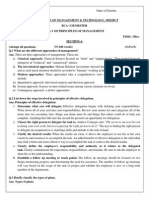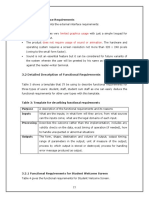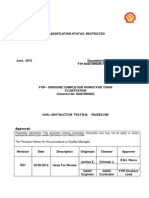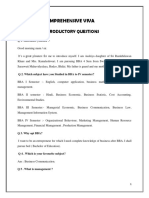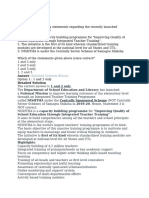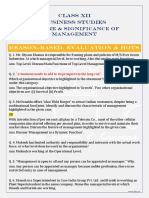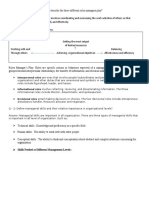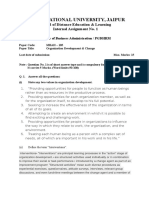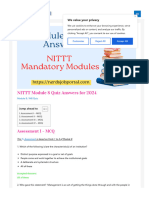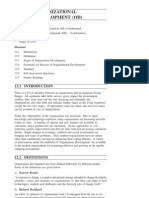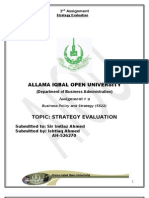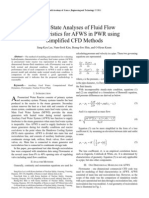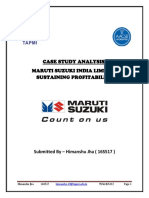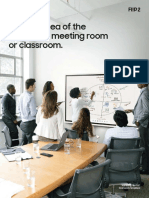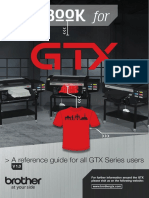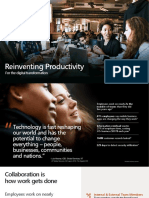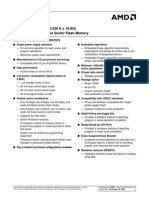Cbse 12 Business Studies 2011 Answer Paper Delhi Set1 PDF
Cbse 12 Business Studies 2011 Answer Paper Delhi Set1 PDF
Uploaded by
Anonymous cPXpNYnBCopyright:
Available Formats
Cbse 12 Business Studies 2011 Answer Paper Delhi Set1 PDF
Cbse 12 Business Studies 2011 Answer Paper Delhi Set1 PDF
Uploaded by
Anonymous cPXpNYnBOriginal Title
Copyright
Available Formats
Share this document
Did you find this document useful?
Is this content inappropriate?
Copyright:
Available Formats
Cbse 12 Business Studies 2011 Answer Paper Delhi Set1 PDF
Cbse 12 Business Studies 2011 Answer Paper Delhi Set1 PDF
Uploaded by
Anonymous cPXpNYnBCopyright:
Available Formats
Business Studies
Exam Year
CBSE Class XII
2011
S tudy. Assig nments. Free Forever. CBSE Question and A nswers.
General instructions:
I) Answers to questions carrying 1 mark may be from one word to one sentence.
II) Answers to questions carrying 3 marks may be from 50-75 words.
III) Answers to questions carrying 4-5 marks may be about 150 words.
IV) Answers to questions carrying 6 marks may be about 200 words.
V) Attempt all parts of a question together.
(1 Mark Questions Q1 to Q10)
Q 1: Your grandfather has retired as the Director of a manufacturing company. At which level
of Management was he working? Different type of functions are performed at this level. State
anyone function.
Answer:
As he retired as director of company, he belongs to top level management. The functions
performed at this level include, strategic decision making.
Q 2: What is meant by management?
Answer:
Management is the act of getting people together to accomplish desired goals and objectives
using available resources effectively and efficiently.
Q 3: What is meant by principles of management?
Answer:
Management Principles are guidelines to take decisions or actions while practicing managerial
techniques. They are basic truths or guidelines for behavior.
Q 4: State anyone principle of scientific management.
Answer:
Science, Not Rule of Thumb: This principle says that we should not get stuck in a set routine
with the old techniques of doing work, rather we should be constantly experimenting to
develop new techniques which make the work much simpler, easier and quicker.
Li k e . S h a r e . B o o k m a r k . D o w n l o a d . M a r k N o t e s . P r i n t . Y o u r F a v o u r i t e Q u e s t i o n s . J o i n w w w . z i g y a . c o m
Page 1 of 16
Business Studies
Exam Year
CBSE Class XII
2011
S tudy. Assig nments. Free Forever. CBSE Question and A nswers.
Q 5: "The understanding of business environment helps the managers to identify 'threats'."
What is meant by 'threats' here?
Answer:
An organization is exposed to external environment, which is dynamic in nature. Threats are
anything from an organization's external environment that can adversely affect its
performance or achievement of goals.
Q 6: 'Business environment includes both 'specific and general forces.' List any four specific
forces.
Answer:
Specific forces of business environment include investors, customers, competitors and
suppliers. It affects individual enterprises directly and immediately in their day-to-day
working.
Q 7: Explain in one sentence how direction initiates action in management.
Answer:
Directing is a function of initiating action by means of giving instructions and guidance to
people for doing work, while other functions like planning, organizing, staffing etc are
preparatory functions.
Q 8: Why it is said that "controlling is a continuous activity?
Answer:
Controlling function cannot be confined to a particular stage and it has no end anywhere. It
is a continuous process of establishing standards, measuring performance, comparing, fixing
deviations and giving feedback for better performance.
Q 9: What is important while analyzing deviations in controlling?
Answer:
While analyzing deviations, it is important to determine the acceptable range of deviations.
Deviations in key areas of business need to be attended more urgently as compared to
deviations in certain insignificant areas.
Q 10: Define Financial Management.
Answer:
Financial Management is defines as all activities concerned with the planning, raising,
controlling and administering of funds used in the business. It is concerned with the
Li k e . S h a r e . B o o k m a r k . D o w n l o a d . M a r k N o t e s . P r i n t . Y o u r F a v o u r i t e Q u e s t i o n s . J o i n w w w . z i g y a . c o m
Page 2 of 16
Business Studies
Exam Year
CBSE Class XII
2011
S tudy. Assig nments. Free Forever. CBSE Question and A nswers.
procurement and utilisation of funds in a proper manner so as to accomplish the objectives
of the organization.
(3 Mark Questions Q11 to Q15)
Q 11: Explain any two impacts of Government policy changes on Business and Industry.
Answer:
Increased competition: Changes in government policies, especially, the New Industrial Policy,
1991 deregulated the industrial economy in a substantial manner through privatisation,
liberalisation and globalisation. It resulted in increased competition for Indian firms from both
domestic and foreign countries.
More demanding consumers: Due to globalisation and information technology boom,
consumers became well aware of the availability of different products in the market. Due to
wider choice for products, consumers became more demanding and specific about the quality,
price and features of the products.
Q 12: Differentiate between 'Policy' and 'Rule' as types of Plans.
Answer:
Policies are general statements that guide thinking or channelise energies towards a particular
direction. Policies provide a basis for interpreting strategy which is usually stated in general
terms
Rules are specific statements that inform what is to be done. They do not allow for any
flexibility or discretion. It reflects a managerial decision that a certain action must or must
not be taken.
Q 13: Why is staffing considered an important function of management in all types of
organisations? State any three reasons.
Answer:
The staffing is considered as an important function of management as,
i) It helps in discovering and obtaining competent personnel for various jobs,
ii) It makes for higher performance, by putting right person on the right job,
iii) It ensures the continuous survival and growth of the enterprise through the succession
planning for managers.
Li k e . S h a r e . B o o k m a r k . D o w n l o a d . M a r k N o t e s . P r i n t . Y o u r F a v o u r i t e Q u e s t i o n s . J o i n w w w . z i g y a . c o m
Page 3 of 16
Business Studies
Exam Year
CBSE Class XII
2011
S tudy. Assig nments. Free Forever. CBSE Question and A nswers.
Q 14: Explain the concept of 'Motivation' and 'Leadership'.
Answer:
Motivation: is the process of stimulating people to action, to accomplish desired goals. It is
an act of stimulating someone or oneself to get a desired course of action. It helps to identify
and satisfy the needs of human resources in the organisation and thereby helps in improving
their performance
Leadership: It is the process of influencing the behavior of others to work willingly and
enthusiastically for achieving predetermined goals. It indicates the ability of an individual to
maintain good interpersonal relations with followers and motivate them to contribute for
achieving organisational objectives.
Q 15: Explain any two functions of 'marketing'.
Answer:
1. Gathering and Analysing Market Information: One of the important functions of marketing
is to gather and analyse market information. It helps to identify the needs of the customers
and take various decisions for the successful marketing of the products and services. It also
helps to analyse various opportunities and threats as well as strengths and weaknesses of the
organization.
2. Marketing Planning: Another important activity of a marketer is to develop suitable
marketing plans so that the marketing objectives of the organisation can be achieved.
(4 Mark Questions Q16 to Q20)
Q 16: State any four features of planning.
Answer:
Planning is deciding in advance what is to be done. Its important features include:
i) Planning focuses on achieving objectives: Planning involves certain steps like determination
of objectives, and development of policies, programs and procedures to achieve the objectives
of organisation.
ii) Planning is a primary function of management: Planning lays down the base for other
functions of management. All other managerial functions are performed within the framework
of the plans drawn. Thus, planning precedes other functions. This is also referred to as the
primacy of planning.
iii) Planning is pervasive: Planning is required at all levels of management as well as in all
departments of the organisation. It is not an exclusive function of top management nor of
any particular department.
iv) Planning is continuous: Plans are prepared for a specific period of time, may be for a
month, a quarter, or a year. At the end of that period there is need for a new plan to be
Li k e . S h a r e . B o o k m a r k . D o w n l o a d . M a r k N o t e s . P r i n t . Y o u r F a v o u r i t e Q u e s t i o n s . J o i n w w w . z i g y a . c o m
Page 4 of 16
Business Studies
Exam Year
CBSE Class XII
2011
S tudy. Assig nments. Free Forever. CBSE Question and A nswers.
drawn on the basis of new requirements and future conditions. Hence, planning is a
continuous process.
Q 17: "If we delegate the authority, we multiply it by two, if we decentralize it, we multiply
it by many." In the light of this statement explain any four points of importance of
decentralization.
Answer:
Delegation refers to the downward transfer of authority from a superior to a subordinate.
However decentralization refers to delegation of authority throughout all the levels of the
organization. Decision making authority is shared with lower levels and is consequently placed
nearest to the points of action. Importance of decentralization is wider than delegation of
authority which is mere transfer of authority from a superior to a subordinate.
Decentralization is a fundamental step and its importance are as follows:
i) It develops initiative among subordinates: Decentralisation helps to promote self-reliance
and confidence amongst the subordinates. A decentralisation policy helps to identify those
executives who have the necessary potential to become dynamic leaders.
ii) Develops managerial talent for the future: Decentralisation gives employees a chance to
prove their abilities and creates a reservoir of qualified manpower who can be considered to
fill up more challenging positions through promotions.
iii) Quick decision making: In a decentralised organisation, as decisions are taken at levels
which are nearest to the points of action, there is no requirement for approval from many
levels, the process is much faster.
iv) Relief to top management: Decentralisation diminishes the amount of direct supervision
exercised by a superior over the activities of a subordinate because they are given the
freedom to act and decide within the limits set by the superior.
Q 18: What is meant by 'Budgetary Control' as a technique of controlling? State any three
advantages of it.
Answer:
Budgetary control is defined as a technique of managerial control in which budgets relating
to the responsibilities of executives are established and continuous comparison of actual with
standards is made. This comparison reveals the necessary actions to be taken so that
organisational objectives are accomplished.
Advantages of budgetary control includes:
1) Budgeting focuses on specific and time-bound targets and thus, helps in attainment of
organisational objectives.
2) Budgeting is a source of motivation to the employees who know the standards against
which their performance will be appraised and thus, enables them to perform better.
Li k e . S h a r e . B o o k m a r k . D o w n l o a d . M a r k N o t e s . P r i n t . Y o u r F a v o u r i t e Q u e s t i o n s . J o i n w w w . z i g y a . c o m
Page 5 of 16
Business Studies
Exam Year
CBSE Class XII
2011
S tudy. Assig nments. Free Forever. CBSE Question and A nswers.
3) Budgeting helps in optimum utilisation of resources by allocating them according to the
requirements of different departments.
Q 19: What is meant by 'Money Market? Explain any two instruments used in Money Market.
Answer:
Money market refers to institutional arrangements, which deals with short term securities.
These assets are close substitutes for money. It is a market where low risk, unsecured and
short term debt instruments that are highly liquid are issued and actively traded everyday. It
has no physical location, but is an activity conducted over the telephone and through the
internet. It enables the raising of short-term funds for meeting the temporary shortages of
cash and obligations and the temporary deployment of excess funds for earning returns
Money market instruments:
1) Call/Notice money: is an amount borrowed or lent on demand for a very short period. It is
short-term finance repayable on demand, with a maturity period of one to fifteen days. The
money that is lent for one day in this market is known as "call money" and, if it exceeds one
day, is referred to as "notice money." No collateral security is required to cover these
transactions. Call money is a method by which banks borrow from each other to maintain the
cash reserve ratio. The interest rate paid on call money loans is known as the call rate.
2) Certificate of Deposits (CDs): They are unsecured, negotiable short term instruments
issued by banks and financial institutions to raise large amount of money. These are issued
in the form of Promissory Notes with maturity ranging from 7 days to one year. The minimum
maturity period of a certificate of deposit is between 7 days and one year. They are freely
transferable after 45 days of the date of issue.
Q 20: 'In to-day's commercial world, the Stock-Exchange performs many vital functions which
leads the investors towards positive environment.' Explain how by giving any four reasons.
Answer:
Stock exchange is an organized market for free purchase and sale of industrial securities. It
provides a ready market for the securities.
1. Providing Liquidity and marketability to Existing Securities: The basic function of a stock
exchange is the creation of a continuous market where securities are bought and sold. It gives
investors the chance to disinvest and reinvest. This provides both liquidity and easy
marketability to already existing securities in the market.
2. Pricing of Securities: Share prices on a stock exchange are determined by the forces of
demand and supply. A stock exchange is a mechanism of constant valuation through which
the prices of securities are determined. Such a valuation provides important instant
information to both buyers and sellers in the market.
3. Safety of Transaction: The membership of a stock exchange is well regulated and its
dealings are well defined according to the existing legal framework. This ensures that the
investing public gets a safe and fair deal on the market.
Li k e . S h a r e . B o o k m a r k . D o w n l o a d . M a r k N o t e s . P r i n t . Y o u r F a v o u r i t e Q u e s t i o n s . J o i n w w w . z i g y a . c o m
Page 6 of 16
Business Studies
Exam Year
CBSE Class XII
2011
S tudy. Assig nments. Free Forever. CBSE Question and A nswers.
4. Contributes to Economic Growth: A stock exchange is a market in which existing securities
are resold or traded. Through this process of disinvestment and reinvestment savings get
channelized into their most productive investment avenues. This leads to capital formation
and economic growth.
(5 Mark Questions Q21 to Q25)
Q 21: "Management is regarded as an Art by some, as Science or as an inexact Science by
others. The truth seems to be somewhere in between." In the light of this statement explain
the true nature of management.
Answer:
Management as an Art:
Art is the application of know-how and personal skill in a particular situation to achieve desired
results. The basic features of an art are as follows:
1) It involves acquisition of skills and ability.
2) It aims to achieve concrete results.
3) Continuous practice is required to get perfection.
4) Existence of theoretical knowledge
5) Personalized application
6) Based on practice and creativity
Management can be said to be an art since it satisfies the following criteria:
(i) A successful manager practices the art of management in the day-to-day job of managing
an enterprise based on study, observation and experience. There is a lot of literature available
in various areas of management which the manager has to specialize in.
(ii) There are various theories of management, which prescribe certain universal principles. A
manager applies these scientific methods and body of knowledge to a given situation, an issue
or a problem, in his own unique manner
(iii) A manager applies this acquired knowledge in a personalized and skillful manner in the
light of the realities of a given situation. He is involved in the activities of the organization,
studies critical situations and formulates his own theories for use in a given situation.
Management as science:
The basic features of science are as follows.
1) Science is defined as a systematic body of knowledge based on observations,
experimentation and intelligent speculation.
2) It explains the cause and effect relationship between different variables.
Li k e . S h a r e . B o o k m a r k . D o w n l o a d . M a r k N o t e s . P r i n t . Y o u r F a v o u r i t e Q u e s t i o n s . J o i n w w w . z i g y a . c o m
Page 7 of 16
Business Studies
Exam Year
CBSE Class XII
2011
S tudy. Assig nments. Free Forever. CBSE Question and A nswers.
3) It verifies the authenticity of knowledge acquired.
4) It comprises basic principles applicable universally and capable of use for predictive
purposes.
Based on the above features, we can say that management has some characteristics of
science.
(i) Management has a systematized body of knowledge
(ii) The principles of management have evolved over a period of time based on repeated
experimentation and observation in different types of organisations. However, since
management deals with human beings and human behaviour, the outcomes of these
experiments are not capable of being accurately predicted or replicated. Therefore,
management can be called an inexact science.
(iii) Since the principles of management are not as exact as the principles of science, their
application and use is not universal. They have to be modified according to a given situation.
Thus management has features of both art and science. The practice of management is an
art. However, managers can work better if their practice is based on the principles of
management. These principles constitute the science of management. Management as an art
and a science are therefore not mutually exclusive, but complement each other.
Q 22: Explain any two techniques of Taylor's Scientific Management.
Answer:
According to F W Taylor, Scientific Management means setting exactly what you want men
to do and seeing that they do it in the best and the cheapest way. Techniques of scientific
management includes:
Method study: The objective of method study is to find out one best way of doing the job.
There are various methods of doing the job. To determine the best way there are several
parameters. Right from procurement of raw materials till the final product is delivered to the
customer every activity is part of method study. Taylor devised the concept of assembly line
by using method study
Motion study: Motion study refers to the study of movements like lifting, putting objects,
sitting and changing positions etc., which are undertaken while doing a typical job.
Unnecessary movements are sought to be eliminated so that it takes less time to complete
the job efficiently.
On close examination of motions, it is possible to find out:
(i) Motions which are productive
(ii) Motions which are incidental
(iii) Motions which are unproductive.
Li k e . S h a r e . B o o k m a r k . D o w n l o a d . M a r k N o t e s . P r i n t . Y o u r F a v o u r i t e Q u e s t i o n s . J o i n w w w . z i g y a . c o m
Page 8 of 16
Business Studies
Exam Year
CBSE Class XII
2011
S tudy. Assig nments. Free Forever. CBSE Question and A nswers.
Taylor used stopwatches and various symbols and colours to identify different motions.
Through motion studies, Taylor was able to design suitable equipment and tools to educate
workers on their use. It helps in saving in time and cost apart from reducing fatigue.
Q 23: "Internal sources of recruitment are better than external sources of recruitment."
Explain any five reasons in support of this statement.
Answer:
Internal sources of recruitment are the means of getting or recruiting the workers from the
existing staff of the organization. In many cases, recruitment from within the organization or
through internal transfers is always better than external sources. The reasons are as follows:
i) Employees are motivated to improve their performance: A promotion at a higher level may
lead to a chain of promotion at lower levels in the organisation. This motivates the employees
to improve their performance through learning and practice. Employees work with
commitment and loyalty and remain satisfied with their jobs. Also peace prevails in the
enterprise because of promotional avenues.
ii) Internal recruitment simplifies the process of selection and placement: The candidates that
are already working in the enterprise can be evaluated more accurately and economically.
This is a more reliable way of recruitment since the candidates are already known to the
organization.
iii) Transfer is a tool of training the employees to prepare them for higher jobs. Also people
recruited from within the organisation do not need induction training
iv) Transfer has the benefit of shifting workforce from the surplus departments to those
where there is shortage of staff.
v) Filling of jobs internally is cheaper as compared to getting candidates from external
sources.
Q 24: 'Determining the relative proportion of various types of funds depends upon various
factors.' Explain any five such factors.
Answer:
Capital structure refers to the proportion of a companys capital, financed through owners and
borrowed funds. Determining the relative proportion of various types of funds depends upon
various factors, and they are:
1) Cost of debt: A firms ability to borrow at a lower rate increases its capacity to employ
higher debt. Thus, more debt can be used if debt can be raised at a lower rate
2) Tax Rate: Since interest is a deductible expense, cost of debt is affected by the tax rate.
A higher tax rate, makes debt relatively cheaper and increases its attraction vis--vis equity.
3) Cost of Equity: Stock owners expect a rate of return from the equity which comes with the
risk they are assuming. When a company increases debt, the financial risk faced by the equity
Li k e . S h a r e . B o o k m a r k . D o w n l o a d . M a r k N o t e s . P r i n t . Y o u r F a v o u r i t e Q u e s t i o n s . J o i n w w w . z i g y a . c o m
Page 9 of 16
Business Studies
Exam Year
CBSE Class XII
2011
S tudy. Assig nments. Free Forever. CBSE Question and A nswers.
holders, increases. Consequently, their desired rate of return may increase. It is for this
reason that a company cannot use debt beyond a point.
4) Floatation Costs: Process of raising resources also involves some cost. Public issue of
shares and debentures requires considerable expenditure. Getting a loan from a financial
institution may not cost so much. These considerations may also affect the choice between
debt and equity and hence the capital structure.
5). Control: Debt normally does not cause a dilution of control. A public issue of equity may
reduce the managements holding in the company and make it vulnerable to takeover. This
factor also influences the choice between debt and equity especially in companies in which
the current holding of management is on a lower side
Q 25: What is meant by 'Brand Name? State any four characteristics of a good 'Brand Name'.
Answer:
Brand Name is a part of a brand consisting of words, letters and group of words or letters
comprising a name which is intended to identify the goods or services of a seller or a group
of sellers and to differentiate them from those of competitors. Example, Promise tooth paste,
Safola, Maggie, Lifebuoy, Dunlop, and Rexona are the brand names.
Characteristics of Good Brand Name:
Following are the characteristics of a good brand name.
i) The brand name should be short, easy to pronounce, spell, recognise and remember e.g.,
lux, VIP, Rin, Vim, etc.
ii) A brand should suggest the products benefits and qualities. It should be appropriate to the
products function. e.g. Trustme, Promise, Fair and lovely and Boost.
iii) A brand name should be distinctive e.g., Liril, Sprit, Zodiac.
iv) The brand name should be adaptable to packing or labelling requirements, to different
advertising media and to different languages.
v) The brand name should be sufficiently versatile to accommodate new products, which are
added to the product line e.g., Maggie, Colgate.
Vi) It should be capable of being registered and protected legally.
(6 Mark Questions Q26 to Q30)
Q 26: What is meant by 'Functional Structure' of an organisation? State any five advantages
of this form of organizational structure.
Answer:
Functional structure comprises of grouping of jobs of similar nature under functional and
organizing these major functions as separate. In this, the whole activities of the enterprise
Li k e . S h a r e . B o o k m a r k . D o w n l o a d . M a r k N o t e s . P r i n t . Y o u r F a v o u r i t e Q u e s t i o n s . J o i n w w w . z i g y a . c o m
Page 10 of 16
Business Studies
Exam Year
CBSE Class XII
2011
S tudy. Assig nments. Free Forever. CBSE Question and A nswers.
are divided into different functions like marketing, finance, personnel etc. Functional
specialists are appointed at different functional levels. They can give orders and directions to
all subordinates in connection with their function. All departments report to a coordinating
head.
Advantages of a functional structure of organisation are:
1) Specialization: A functional structure leads to occupational specialisation since emphasis is
placed on specific functions. This promotes efficiency in utilisation of manpower as employees
perform similar tasks within a department and are able to improve performance.
2) Better control and coordination: It promotes control and coordination within a department
because of similarity in the tasks being performed.
3) Maintenance of higher efficiency: It helps in increasing managerial and operational
efficiency and this results in increased profit.
4) Economies of scale: It leads to minimal duplication of effort which results in economies of
scale and this lowers cost.
5) No overload of work: The entire work is divided into various functions and is assigned to
different functional experts. So managers are not overloaded with work.
.
OR
What is meant by 'Formal Organisation'? State any five advantages of this form of
organisation.
Answer:
Formal organisation refers to the organisation structure which is designed by the management
to accomplish a particular task. It specifies clearly the boundaries of authority and
responsibility and there is a systematic coordination among the various activities to achieve
organisational goals. The structure in a formal organisation can be functional or divisional. It
is usually developed for a continuous purpose involving activities of repetitive nature and long
term operations.
Advantages of a Formal organisation are the following.
1) It is easier to fix responsibility since mutual relationships are clearly defined.
2) There is no ambiguity in the role that each member has to play as duties are specified.
This also helps in avoiding duplication of effort.
3) Unity of command is maintained through an established chain of command.
4) It leads to effective accomplishment of goals by providing a framework for the operations
to be performed and ensuring that each employee knows the role he has to play.
Li k e . S h a r e . B o o k m a r k . D o w n l o a d . M a r k N o t e s . P r i n t . Y o u r F a v o u r i t e Q u e s t i o n s . J o i n w w w . z i g y a . c o m
Page 11 of 16
Business Studies
Exam Year
CBSE Class XII
2011
S tudy. Assig nments. Free Forever. CBSE Question and A nswers.
5) It provides stability to the organisation. This is because behaviour of employees can be
fairly predicted since there are specific rules to guide them.
Q 27: Explain any four semantic barriers of communication.
Answer:
Semantic barriers are concerned with problems and obstructions in the process of encoding
and decoding of message into words or impressions. Normally, such barriers result on account
of use of wrong words, faulty translations, different interpretations etc.
Sematic barriers are the following:
(i) Badly expressed message: Sometimes intended meaning may not be conveyed by a
manager to his subordinates. These badly expressed messages may be an account of
inadequate vocabulary, usage of wrong words, omission of needed words etc.
(ii) Symbols with different meanings: A word may have several meanings. Receiver has to
perceive one such meaning for the word used by communicator. Wrong perception leads to
communication problems.
(iii) Faulty translations: Sometimes the communications originally drafted in one language
need to be translated to the language understandable to workers. If the translator is not
proficient with both the languages, mistakes may creep in causing different meanings to the
communication.
(v) Technical jargon: It is usually found that specialists use technical jargon while explaining
to persons who are not specialists in the concerned field. Therefore, they may not understand
the actual meaning of many such words.
Explain the role of supervision as an element of directing function of management.
Answer:
Being an element of directing, every manager in the organisation supervises his subordinates.
In this sense, supervision can be understood as the process of guiding the efforts of
employees and other resources to accomplish the desired objectives. It means overseeing
what is being done by subordinates and giving instructions to ensure optimum utilisation of
resources and achievement of work targets.
Roles performed by a supervisor are explained below:
(i) Supervisor maintains day-to-day contact and maintains friendly relations with workers. A
good supervisor acts as a guide, friend and philosopher to the workers.
(ii) Supervisor acts as a link between workers and management. He conveys management
ideas to the workers on one hand and workers problems to the management on the other.
This role played by supervisor helps to avoid misunderstandings and conflicts between
management and workers/employees.
Li k e . S h a r e . B o o k m a r k . D o w n l o a d . M a r k N o t e s . P r i n t . Y o u r F a v o u r i t e Q u e s t i o n s . J o i n w w w . z i g y a . c o m
Page 12 of 16
Business Studies
Exam Year
CBSE Class XII
2011
S tudy. Assig nments. Free Forever. CBSE Question and A nswers.
(iii) Supervisor plays a key role in maintaining group unity among workers placed under his
control. He sorts out internal differences and maintains harmony among workers.
(iv) Supervisor ensures performance of work according to the targets set. He takes
responsibility for task achievement and motivates his workers effectively.
(v) Supervisor provides good onthe-job training to the workers and employees. A skilled and
knowledgeable supervisor can build efficient team of workers.
(vi) Supervisory leadership plays a key role in influencing the workers in the organisation. A
supervisor with good leadership qualities can build up high morale among workers.
(vii) A good supervisor analyses the work performed and gives feedback to the workers. He
suggests ways and means of developing work skills.
Q 28: "Sound Financial Planning is essential for the success of any business enterprise."
Explain this statement by giving any six reasons.
Answer:
A sound financial planning is an important part for the success of any business enterprise. It
aims at enabling the company to tackle the uncertainty in respect of the availability and timing
of the funds and helps in smooth functioning of an organisation.
The importance of financial planning are:
(i) It helps in forecasting what may happen in future under different business situations. By
doing so, it helps the firms to face the eventual situation in a better way. By preparing a
blueprint of these three situations the management may decide what must be done different
situations.
(ii) It helps in avoiding business shocks and surprises and helps the company in preparing for
the future.
(iii) If helps in co-ordinating various business functions, e.g., sales and production functions,
by providing clear policies and procedures.
(iv) Detailed plans of action prepared under financial planning reduce waste, duplication of
efforts, and gaps in planning.
(v) It tries to link the present with the future.
(vi) It provides a link between investment and financing decisions on a continuous basis.
OR
You are the Financial Manager of a newly established company. The Directors have asked
you to determine the amount of working capital requirement for the company. Explain any
four factors that you will consider while determining the working capital requirement for the
company.
Li k e . S h a r e . B o o k m a r k . D o w n l o a d . M a r k N o t e s . P r i n t . Y o u r F a v o u r i t e Q u e s t i o n s . J o i n w w w . z i g y a . c o m
Page 13 of 16
Business Studies
Exam Year
CBSE Class XII
2011
S tudy. Assig nments. Free Forever. CBSE Question and A nswers.
Answer:
Determination of amount of fixed capital is to be done very cautiously as it involves large
amount of fund, impact is for long term, existence of high risk, and decision is irreversible.
Factors to be considered are:
1) Nature of Business: The type of business has a bearing upon the fixed capital requirements.
For example, a trading concern needs lower investment in fixed assets compared with a
manufacturing organisation; since it does not require to purchase plant and machinery, etc
2) Scale of Operations: A larger organisation operating at a higher scale needs bigger plant,
more space etc. and therefore, requires higher investment in fixed assets when compared
with the small organisation.
3) Choice of Technique: Some organisations are capital intensive whereas others are labour
intensive. A capital-intensive organisation requires higher investment in plant and machinery
as it relies less on manual labour. The requirement of fixed capital for such organisations
would be higher. Labour intensive organisations on the other hand require less investment in
fixed assets. Hence, their fixed capital requirement is lower.
4) Growth Prospects: Higher growth of an organisation generally requires higher investment
in fixed assets. Even when such growth is expected, a company may choose to create higher
capacity in order to meet the anticipated higher demand quicker. This entails larger
investment in fixed assets and consequently larger fixed capital.
Q 29: Name the element of Marketing-mix in which a set of firms and individuals creates
possession, place and time utility and helps in market offering. Also explain any five important
functions performed by this element.
Answer:
The element of marketing mix that creates possession, place and time utility is Place or
Physical Distribution mix. It include activities that make firms products available to the target
customers. Important decision areas in this respect include selection of dealers or
intermediaries to reach the customers, providing support to the intermediaries.
Important functions performed by physical distribution mix are:
1. Sorting: Middlemen procure supplies of goods from a variety of sources, which is often not
of the same quality, nature, and size. So he sort the product into homogenous groups on the
basis of the size or quality.
2. Accumulation: This function involves accumulation of goods into larger homogeneous
stocks, which help in maintaining continuous flow of supply.
3. Allocation: Allocation involves breaking homogenous stock into smaller, marketable lots.
4. Assorting: Middlemen build assortment of products for resale. There is usually a difference
between the product lines made by manufacturers and the assortment or combinations
desired by the users.. Middlemen procure variety of goods from different sources and deliver
them in combinations desired by customers.
Li k e . S h a r e . B o o k m a r k . D o w n l o a d . M a r k N o t e s . P r i n t . Y o u r F a v o u r i t e Q u e s t i o n s . J o i n w w w . z i g y a . c o m
Page 14 of 16
Business Studies
Exam Year
CBSE Class XII
2011
S tudy. Assig nments. Free Forever. CBSE Question and A nswers.
5. Product Promotion: Mostly advertising and other sales promotion activities are organised
by manufacturers. Middlemen also participate in certain activities such as demonstrations,
special displays, contests, etc., to increase the sale of products
OR
Identify and explain the promotional tool of Marketing-mix which plays a persuasive, service
and informative role and thereby link a business firm to its customers. Also explain by giving
any four reasons how this tool helps in increasing the sales of businessmen.
Answer:
The promotional tool of marketing mix which plays a persuasive, service and informative role
and links a business firm to its customers is personal selling. Personal selling involves oral
presentation of message in the form of conversation with one or more prospective customers
for the purpose of making sales.
Personal selling is a powerful tool which helps to increase the sales of businessmen. The
importance of personal selling to a business organisation may be described as follows:
(i) Effective Promotional Tool: Personal selling is very effective promotional tool, which helps
in influencing the prospects about the merits of a product and thereby increasing its sale.
(ii) Flexible Tool: Personal selling is more flexible than other tools of promotion such as
advertising and sales promotion.
(iii) Minimizes Wastage of Efforts: Compared with other tools of promotion, the possibility of
wastage of efforts in personal selling is minimum. This helps the business persons in bringing
economy in their efforts.
(iv) Consumer Attention: There is an opportunity to detect the loss of consumer attention and
interest in a personal selling situation. This helps a business person in successfully completing
the sale.
Q 30: Reena purchased one litre of pure Deshi Ghee from a shopkeeper. After using it she
had a doubt that it is adulterated. She sent it for a laboratory test which confirmed that the
Ghee is adulterated. State any six reliefs available to Reena, if she complaints and the
consumer court is satisfied about the genuineness of the complaint.
Answer:
If Reena complains about the adulteration and could satisfy the consumer court its
genuineness, the following reliefs are available.
(i) To replace the defective Deshi Ghee with a new one, free from any defect.
(ii) To refund the price paid for the product, or the charges paid for the service.
(iii) To pay a reasonable amount of compensation to Reena for any loss or injury/sickness
suffered by the due to the consumption of adulterated ghee.
(iv) To discontinue the unfair/ restrictive trade practice and not to repeat it in the future.
(v)To pay adequate cost to Reena.
Li k e . S h a r e . B o o k m a r k . D o w n l o a d . M a r k N o t e s . P r i n t . Y o u r F a v o u r i t e Q u e s t i o n s . J o i n w w w . z i g y a . c o m
Page 15 of 16
Business Studies
Exam Year
CBSE Class XII
2011
S tudy. Assig nments. Free Forever. CBSE Question and A nswers.
(vi) )To withdraw the hazardous goods from sale.
(vii)To cease manufacture of hazardous goods and to stop offering hazardous services.
OR
Prakhar purchased an ISI mark electric iron from 'Bharat Electricals'. While using he found
that it was not working properly. He approached the seller and complained for the same. The
seller satisfies Prakhar by saying that he will ask the manufacturer to replace this iron. The
manufacturer refused to replace and Bharat Electricals decided to file a complaint in the
consumer court.
Can 'Bharat Electricals' do this? Why? Also explain 'who is a consumer' as per Consumer
Protection Act, 1986
Answer:
According to Consumer Protection Act, 1986, a Consumer is defined as
a) Any person who buys any goods for a consideration, which has been paid or promised, or
partly paid and partly promised, or under any scheme of deferred payment. It includes any
user of such goods, when such use is made with the approval of the buyer, but does not
include a person who obtains goods for re-sale or any commercial purpose.
b) Any person who hires or avails of any service, for a consideration which has been paid or
promised, or partly paid and partly promised, or under any system of deferred payment. It
includes any beneficiary of services when such services are availed of with the approval of
the person concerned, but does not include a person who avails of such services for any
commercial purpose.
Here Bharat Electricals cannot file a complaint as it is not a consumer as per the Consumer
Protection Act 1986 Act and it has purchased good from the manufacturer for commercial
purpose that is reselling.
Li k e . S h a r e . B o o k m a r k . D o w n l o a d . M a r k N o t e s . P r i n t . Y o u r F a v o u r i t e Q u e s t i o n s . J o i n w w w . z i g y a . c o m
Page 16 of 16
You might also like
- (Ebooks PDF) Download Industrial Communication Technology Handbook Second Edition Richard Zurawski Full ChaptersDocument62 pages(Ebooks PDF) Download Industrial Communication Technology Handbook Second Edition Richard Zurawski Full Chapterspizarotejt100% (3)
- Organizational BehaviorDocument29 pagesOrganizational BehaviorTrung Thu100% (2)
- Bca 1st Sem P.O.MDocument52 pagesBca 1st Sem P.O.MsinghalitiNo ratings yet
- 2012 Semester 1 MG 101 Final PaperDocument11 pages2012 Semester 1 MG 101 Final PaperGrace Versoni100% (1)
- Chapter 1 Management and OrganizationsDocument12 pagesChapter 1 Management and OrganizationsBo Zydarin100% (2)
- Microsoft Word - SRSDocument5 pagesMicrosoft Word - SRSnonip100% (1)
- NDT ProcedureDocument29 pagesNDT Procedureisukuru80% (5)
- 12 Business Studies Lyp 2014 Comp Delhi Set 1Document11 pages12 Business Studies Lyp 2014 Comp Delhi Set 1Ashish GangwalNo ratings yet
- Comprehensive Viva of AashiyaDocument23 pagesComprehensive Viva of AashiyaMegha UikeNo ratings yet
- Hots Business StudiesDocument37 pagesHots Business StudiesDaniel RobertNo ratings yet
- Nikhil Kumar MB 0038: SMU AssignmentDocument6 pagesNikhil Kumar MB 0038: SMU AssignmentNick SinNo ratings yet
- Principle of Mangement Test Bank Chapter 5Document19 pagesPrinciple of Mangement Test Bank Chapter 5MÆa HâNo ratings yet
- School Administration and Supervision - 2Document6 pagesSchool Administration and Supervision - 2ZeeshanNo ratings yet
- combinepdfDocument4 pagescombinepdfgayax32822No ratings yet
- 1876119754bst Sure Shot QuestionsDocument63 pages1876119754bst Sure Shot QuestionsMaxNo ratings yet
- Terminals Answers - ImportantDocument22 pagesTerminals Answers - Importantsanjeev misraNo ratings yet
- MB0038 - Management Process and Organisational BehaviourDocument8 pagesMB0038 - Management Process and Organisational BehaviourvinodniralaNo ratings yet
- Org Grade 11 SummaryDocument7 pagesOrg Grade 11 SummaryEmmanuel Guevarra Jr.No ratings yet
- Important Questions For CBSE Class 12 Business Studies Chapter 1Document8 pagesImportant Questions For CBSE Class 12 Business Studies Chapter 1Jui BNo ratings yet
- Class Xii Business Studies: Reason-Based, Evaluation & HotsDocument12 pagesClass Xii Business Studies: Reason-Based, Evaluation & HotsAnshuman SajwanNo ratings yet
- Short Question Answers ManagementDocument13 pagesShort Question Answers ManagementRajesh Mg100% (1)
- Management of Organization MidtermDocument8 pagesManagement of Organization MidtermMd. Pabel AhmedNo ratings yet
- Case Study 6 Intermediate - Reinventing Performance ManagementDocument10 pagesCase Study 6 Intermediate - Reinventing Performance ManagementMaría LugoNo ratings yet
- Course Work For Business AdministrationDocument31 pagesCourse Work For Business AdministrationTusiime Wa Kachope SamsonNo ratings yet
- Class 12 Business Studies Chapter-4 Planning Important QuestionsDocument11 pagesClass 12 Business Studies Chapter-4 Planning Important QuestionsSmita SrivastavaNo ratings yet
- Solved Prepratry Question Paper 2020Document14 pagesSolved Prepratry Question Paper 2020Grace Elderly CareNo ratings yet
- 12 Business Studies Lyp 2012 Delhi Set 1Document20 pages12 Business Studies Lyp 2012 Delhi Set 1Ashish GangwalNo ratings yet
- MB0038 Assignment Spring 2013Document7 pagesMB0038 Assignment Spring 2013Smu SovabazarNo ratings yet
- Principle of Management 1427 Important QuestionsDocument35 pagesPrinciple of Management 1427 Important QuestionsNaveed Hussain KhokharNo ratings yet
- Mbah 105Document10 pagesMbah 105jithindas0550% (2)
- Management Skills Interview Questions and Answers Guide.: Global GuidelineDocument7 pagesManagement Skills Interview Questions and Answers Guide.: Global Guidelinerdan00313No ratings yet
- BST 12th 6 J7 J8 J9Document7 pagesBST 12th 6 J7 J8 J9Divyansh SharmaNo ratings yet
- M8 Quis&PYQDocument209 pagesM8 Quis&PYQkarthi0389No ratings yet
- AllChapters Questions MergedDocument182 pagesAllChapters Questions Merged07dc855dbbb4No ratings yet
- Business Studies XiiDocument93 pagesBusiness Studies XiiramanagpalNo ratings yet
- Document 10Document8 pagesDocument 10Red AstarNo ratings yet
- Principal of ManagementDocument9 pagesPrincipal of ManagementGau Rav AsharaNo ratings yet
- Smu Assignments Semester FirstDocument7 pagesSmu Assignments Semester FirstDevendra KachhiNo ratings yet
- Management Principle and Application NOTESDocument46 pagesManagement Principle and Application NOTESishubhy111No ratings yet
- BST SolutionsDocument154 pagesBST Solutionsmr.deivanayagam.mNo ratings yet
- CH1 ManagementDocument10 pagesCH1 Managementvaishanavir2007No ratings yet
- POM 2 Marks Wit AnsDocument9 pagesPOM 2 Marks Wit Ansgop_santriyaNo ratings yet
- Answer-Worksheets of EntrepreneurshipDocument6 pagesAnswer-Worksheets of EntrepreneurshipJelly Barcelon AcebedoNo ratings yet
- Managers and ManagingDocument164 pagesManagers and ManagingRahul VichareNo ratings yet
- MG2351 2 MarksDocument13 pagesMG2351 2 MarksParandhaman GRNo ratings yet
- The Challenges Leaders Face TodayDocument8 pagesThe Challenges Leaders Face TodaySolomon MainaNo ratings yet
- OD Interventions SummaryDocument15 pagesOD Interventions SummaryVaibhav JainNo ratings yet
- SITXHRM003Document7 pagesSITXHRM003nguyenquoctrung140No ratings yet
- CBSE Class-12 Business Studies Question Paper 2016 All India Set-3Document18 pagesCBSE Class-12 Business Studies Question Paper 2016 All India Set-3Ashish GangwalNo ratings yet
- MB0038 Management Process and Organizational Behavior Assignment Feb 11Document24 pagesMB0038 Management Process and Organizational Behavior Assignment Feb 11सचिन निगुडकरNo ratings yet
- Strategy Evaluation ProcessDocument38 pagesStrategy Evaluation ProcessIshtiaq Ahmed0% (1)
- Module - I NotesDocument21 pagesModule - I NotestojokuttanNo ratings yet
- Learning Metrics That Matter Bray LeinoDocument12 pagesLearning Metrics That Matter Bray LeinoDeirdreNo ratings yet
- Learning Metrics That Matter Bray LeinoDocument12 pagesLearning Metrics That Matter Bray Leinolalagabrielle613No ratings yet
- Activity Sheets OrgDocument3 pagesActivity Sheets OrgMari FranceNo ratings yet
- Guide to Chris McChesney’s & et al The 4 Disciplines of ExecutionFrom EverandGuide to Chris McChesney’s & et al The 4 Disciplines of ExecutionNo ratings yet
- Demystifying Strategic Planning: People-Centered Leadership, #2From EverandDemystifying Strategic Planning: People-Centered Leadership, #2No ratings yet
- Effective Succession Planning: Ensuring Leadership Continuity and Building Talent from WithinFrom EverandEffective Succession Planning: Ensuring Leadership Continuity and Building Talent from WithinRating: 3.5 out of 5 stars3.5/5 (4)
- Developmental Leadership: Equipping, Enabling, and Empowering Employees for Peak PerformanceFrom EverandDevelopmental Leadership: Equipping, Enabling, and Empowering Employees for Peak PerformanceNo ratings yet
- Coaching for Action: A Report on Long-term Advising in a Program Context: A Report on Long-term Advising in a Program ContextFrom EverandCoaching for Action: A Report on Long-term Advising in a Program Context: A Report on Long-term Advising in a Program ContextNo ratings yet
- The Expert Patient: A New Approach To Chronic Disease Management For The 21st CenturyDocument35 pagesThe Expert Patient: A New Approach To Chronic Disease Management For The 21st CenturyPatients Know BestNo ratings yet
- 0900766 b 8140900 eDocument424 pages0900766 b 8140900 eAlireza MoradiNo ratings yet
- 7 Cool and Useful Gadgets For Men - TechfreetricksDocument7 pages7 Cool and Useful Gadgets For Men - TechfreetricksAlexia JacksonNo ratings yet
- Peter Debbins Court FilingDocument20 pagesPeter Debbins Court FilingChuck RossNo ratings yet
- TIB Flogo 2.25.0 Mapper Functions GuideDocument134 pagesTIB Flogo 2.25.0 Mapper Functions GuidePoorna ChNo ratings yet
- United States Court of Appeals, Fourth CircuitDocument4 pagesUnited States Court of Appeals, Fourth CircuitScribd Government DocsNo ratings yet
- Steady-State Analyses of Fluid Flow Characteristics For AFWS in PWR Using Simplified CFD MethodsDocument4 pagesSteady-State Analyses of Fluid Flow Characteristics For AFWS in PWR Using Simplified CFD MethodsViswanathan DamodaranNo ratings yet
- 06 DCIO IB EngDocument5 pages06 DCIO IB EngRawathereNo ratings yet
- Maruti Suzuki 16S517Document6 pagesMaruti Suzuki 16S517Himanshu JhaNo ratings yet
- VentilatorDocument15 pagesVentilatorMohamedNo ratings yet
- 2016 Iter Annual ReportDocument64 pages2016 Iter Annual Reportchachachoudhary4No ratings yet
- Bidding ProcessDocument15 pagesBidding ProcessEngel De Villa100% (2)
- Chernobyl The Legacy Continues Information and Users Guide PDFDocument102 pagesChernobyl The Legacy Continues Information and Users Guide PDFJacopo100% (1)
- The Value of Good DesignDocument11 pagesThe Value of Good DesignchrispittmanNo ratings yet
- مستند بلا عنوانDocument4 pagesمستند بلا عنوانHamzah A. LaftaNo ratings yet
- Samsung Smart TVDocument8 pagesSamsung Smart TVwilliam mutheeNo ratings yet
- El Sewedy Transformers (Hatem Tantawy) Presentation10 & 18 Jan 09Document60 pagesEl Sewedy Transformers (Hatem Tantawy) Presentation10 & 18 Jan 09Lina M. Abd ElSalamNo ratings yet
- Solution Manual For C Programming From Problem Analysis To Program Design 4th Edition Barbara Doyle Isbn 10 1285096266 Isbn 13 9781285096261Document19 pagesSolution Manual For C Programming From Problem Analysis To Program Design 4th Edition Barbara Doyle Isbn 10 1285096266 Isbn 13 9781285096261Gerald Digangi100% (40)
- Chord Scale ThesaurusDocument126 pagesChord Scale ThesaurusColin Schmidt100% (4)
- Cookbook: A Reference Guide For All GTX Series UsersDocument12 pagesCookbook: A Reference Guide For All GTX Series UserskicsispermaNo ratings yet
- Reinventing Productivity ShortDocument8 pagesReinventing Productivity ShortAgusNo ratings yet
- AM29F400BT ChipDocument41 pagesAM29F400BT ChipIvan KopićNo ratings yet
- Highlight HPC168 Passenger Counter HardwareDocument10 pagesHighlight HPC168 Passenger Counter HardwareItsJiONo ratings yet
- Cracking in Walls With Combined Base and Edge Restraint - Authors' VersionDocument28 pagesCracking in Walls With Combined Base and Edge Restraint - Authors' VersionAd FwyNo ratings yet
- Electronic Ticket Receipt: ItineraryDocument2 pagesElectronic Ticket Receipt: ItineraryKi PoaNo ratings yet
- Minimal Invasive Dentistry: Dr. Rabab SalamaDocument36 pagesMinimal Invasive Dentistry: Dr. Rabab SalamanoursiliemNo ratings yet
- Recce Checklist: Things To TakeDocument3 pagesRecce Checklist: Things To TakeFrancescaEllisNo ratings yet



